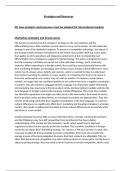Strategies and Resources
P8: How products and processes must be adapted for international markets
Marketing strategies and brand names
The two key components of the company's strategy are the cost emphasis and the
differentiating focus. IKEA combines several tactics to carry out its mission. Its cost leadership
strategy is one of the methods it employs. To preserve a competitive advantage, this aspect of
the strategy entails aiming to manufacture at the lowest cost possible. IKEA has a clear policy
that applies to all its operations and integrates components of the cost leadership and
differentiation focus strategies to support its hybrid strategy. This policy is designed to ensure
that the company's activities are carried out in line with their strategy, and it constantly
improves. When expanding to a foreign market, Ikea could face several potential issues with
their marketing strategies and branding. One of these issues include cultural differences, every
culture has its unique values, beliefs, and customs, and it is essential for Ikea to understand
them before launching its products in a new country. It is important for them to be aware is
that what works well in one country may not work in another. For instance, some colours,
symbols, or images that are considered positive in one culture may have a negative connotation
in another. This also relates to language barriers; language is an important aspect of branding
and marketing. Ikea must ensure that its product names and descriptions translate well into the
local language of foreign countries like Germany and the Philippines. They must also consider
any idiomatic expressions that might not make sense in the new market. Ikea needs to ensure
that its product names and descriptions are translated accurately and appropriately. They also
need to avoid using words that have negative connotations in the local language. In summary,
cultural differences can significantly affect Ikea's marketing and branding strategies in a foreign
country. Ikea needs to understand and adapt to these cultural differences to successfully enter
and thrive in a new market.
Another potential issue that IKEA can have with their items in foreign countries like Germany
and the Philippines may face stiff competition from local brands that have a better
understanding of the market and the customers' needs, which would lead to legal and
regulatory hurdles that are specific to the new markets. The economic conditions of foreign
countries can impact Ikea's marketing strategy. For instance, if the local currency is weak, Ikea
may have to adjust its pricing strategy to remain competitive. They must also consider the
average income of the local population to ensure that their products are affordable. This can
affect IKEA because local competition may offer similar products at a lower price, forcing Ikea to
adjust its pricing strategy. Ikea may need to lower its prices to remain competitive, which could
, affect its profit margins and overall business strategy. It may have a stronger presence in the
local market and a better understanding of the local culture and customs. Ikea may need to
adjust its marketing and advertising strategy to appeal to the local population effectively, along
with investing heavily in building brand awareness and trust with the local population. Local
competition may have a better understanding of the local distribution and logistics systems,
which can affect Ikea's supply chain and logistics operations so they may need to invest in local
distribution and logistics systems to remain competitive in foreign markets. In summary, local
competition can significantly affect Ikea's marketing and branding strategies in a foreign
country. Ikea needs to understand the local competition and adjust its strategies accordingly to
remain competitive and successful in the new market.
Economic factors can have a significant impact on Ikea's marketing and branding strategies in
foreign markets, this includes inflation and recession in disposable income can influence
consumer behaviour. During a recession, for instance, consumers may prioritize essential
purchases over discretionary spending, leading to a decline in sales of non-essential items. Ikea
may respond to such changes by modifying their marketing and branding strategies to
emphasize affordability and value for money. This relates to exchange rate fluctuations, that
can affect the cost of production and pricing in foreign countries. This is a significant factor that
Ikea may have to modify its marketing and branding strategies to reflect changes in costs, such
as emphasizing its eco-friendly sourcing practices or highlighting local production to reduce
transportation costs. Trade regulations, tariffs, and quotas can impact Ikea's ability to enter
foreign markets and affect its pricing strategy. Ikea may need to adjust its marketing and
branding strategies to comply with local regulations, such as emphasizing local sourcing and
production to avoid tariffs or quotas. To succeed in foreign markets, Ikea must understand
these economic factors and adjust its marketing and branding strategies accordingly to remain
relevant and competitive.
To effectively break into foreign markets, Ikea must develop a comprehensive market entry
strategy that considers the unique economic, cultural, and legal factors of each market. Ikea
must conduct extensive market research to identify the cultural, economic, and social factors
that influence consumer behaviour in each market. This research should include analysis of
market size, competition, pricing, distribution channels, and regulatory requirements. Ikea
would have to start off by adapting its furniture goods and services to meet the needs and
preferences of their local consumers. This may include modifying kitchen
designs, sizes, and features to suit local tastes, or offering additional services such as assembly
or delivery to accommodate local logistics. They should develop a localized marketing strategy
that speaks to the unique cultural and economic context of each market. This may involve
adjusting marketing messages, media channels, and advertising formats to suit local
preferences and customs. This can be done by building a strong distribution network that can
efficiently reach customers in each market. This may involve partnering with local distributors,
establishing local warehouses, or setting up new retail stores in strategic locations. This will




